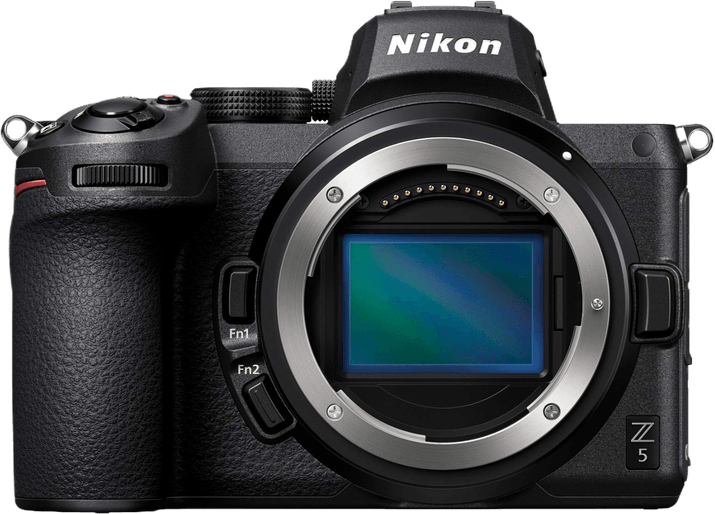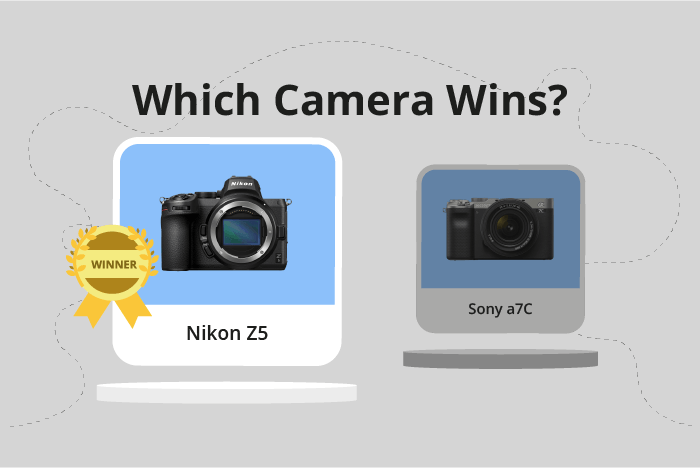Nikon Z5 vs Sony a7C Comparison
Nikon Z5

Sony a7C

The Nikon Z5 and the Sony a7C both score 78/100, making it a tie in terms of overall performance. Both cameras are mirrorless and were released in 2020, with the Z5 announced on 07/21 and the a7C on 11/01. They share common features, but each has its unique advantages.
The Nikon Z5 is larger, measuring 134 x 100.5 x 69.5mm, and weighs 675g. It is priced at $1400, making it more affordable than the Sony a7C. This lower price point provides a better value for users on a budget.
On the other hand, the Sony a7C is more compact, measuring 124 x 71 x 60mm, and weighs only 509g. It is priced at $1799, which is higher than the Nikon Z5. However, its smaller size and lighter weight make it more portable and convenient for on-the-go photography.
Both cameras have their strengths, with the Nikon Z5 offering a better price and the Sony a7C providing greater portability. Ultimately, the choice depends on the user’s preferences and needs.
Nikon Z5 vs Sony a7C Overview and Optics
The Nikon Z5 narrowly edges out the Sony a7C in terms of optics, with a score of 81/100 compared to the a7C’s 80/100. Both cameras share several common specifications, such as having 24 megapixels, CMOS sensor type, full-frame sensor size, and built-in image stabilization. They also have their respective lens mounts: Nikon Z for the Z5 and Sony FE for the a7C.
The Nikon Z5 boasts a higher DXOMARK score for its sensor, at 97, compared to the Sony a7C’s 95. This difference indicates that the Z5 has better overall image quality and low light performance. Additionally, the Z5 is equipped with a more advanced processor, the Expeed 6, which contributes to faster image processing and better noise reduction.
On the other hand, the Sony a7C has a slightly higher megapixel count of 24.2, which may result in marginally better image resolution. The a7C also has a clear advantage in shooting speed, at 10 frames per second, doubling the Z5’s 4.5. This makes the a7C more suitable for capturing fast-moving subjects or action photography.
In terms of optics, the Nikon Z5 offers better image quality and low light performance due to its higher DXOMARK score and more advanced processor. However, the Sony a7C provides faster shooting speed and slightly better image resolution. Choosing between these two cameras will depend on the specific needs and priorities of the photographer. For those who prioritize image quality and low light performance, the Nikon Z5 is the better choice. Conversely, photographers who need faster shooting speeds and higher resolution should opt for the Sony a7C.
Nikon Z5 vs Sony a7C Video Performance
The Nikon Z5 outperforms the Sony a7C in video capabilities with a score of 83/100, a 13-point lead over the Sony a7C’s score of 70/100. Both cameras feature a maximum video resolution of 4K and dimensions of 3840 x 2160, providing high-quality visuals. Additionally, both cameras offer built-in time-lapse functionality, allowing for creative video options.
The Nikon Z5 excels in its maximum video frame rate of 60fps, twice the Sony a7C’s 30fps. This higher frame rate allows for smoother motion capture and improved slow-motion video playback, providing a more versatile video experience for users.
While the Sony a7C falls short in the frame rate category, it still offers the same 4K resolution and time-lapse functionality as the Nikon Z5, making it a viable option for those who prioritize these features. However, its lower video score and frame rate make it less competitive in comparison to the Nikon Z5.
Given the higher video score and superior frame rate, the Nikon Z5 proves to be the better choice for those seeking optimal video performance. The Sony a7C, although not as strong in this aspect, still offers satisfactory video quality with 4K resolution and time-lapse capabilities. Ultimately, users must consider their individual needs and preferences when choosing between these two cameras.
Nikon Z5 vs Sony a7C Features and Benefits
The Sony a7C outperforms the Nikon Z5 with a feature score of 81/100 compared to the Nikon Z5’s 72/100. Both cameras share several specifications, including touchscreen capability, flip screens, WiFi, Bluetooth, and the absence of GPS.
The Sony a7C excels in its overall feature score, which indicates a better camera experience. The Nikon Z5 has a larger screen size at 3.2 inches compared to the Sony a7C’s 3 inches. However, the Sony a7C has a higher screen resolution of 921,600 dots, while the Nikon Z5 has a slightly lower resolution of 1,040,000 dots. This difference in resolution allows the Sony a7C to provide a clearer and sharper image display.
Despite the difference in feature scores, the Nikon Z5 has some advantages. Its larger screen size may appeal to users who prefer more display area for composing and reviewing images. The Nikon Z5 also offers a higher screen resolution, which may be beneficial for photographers who demand more precise image review and composition.
Considering the features of both cameras, the Sony a7C emerges as the winner due to its higher overall score, reflecting better performance in various aspects. The Nikon Z5, though trailing in overall score, offers a larger screen size and slightly higher screen resolution, which may be preferable for some users. Ultimately, the choice between these two cameras will depend on individual preferences and priorities, as both offer a range of features suited to different photography styles and needs.
Nikon Z5 vs Sony a7C Storage and Battery
The Nikon Z5 outperforms the Sony a7C in storage and battery with a score of 73/100, compared to the a7C’s 45/100. Both cameras accept SD, SDHC, and SDXC memory cards (UHS-II compatible) and offer USB charging capabilities. However, the Z5 takes the lead with its dual memory card slots, providing more storage options and backup capabilities than the a7C’s single slot.
Although the Z5’s battery life is shorter at 470 shots compared to the a7C’s 740 shots, its EN-EL15c battery type still performs well. The a7C’s longer battery life, using the NP-FZ100 battery, is its main advantage in this comparison. However, the Z5’s superior storage capabilities give it a clear edge over the a7C.
Considering both storage and battery aspects, the Nikon Z5 proves to be a better choice with its higher score and dual memory card slots, despite a slightly shorter battery life. The Sony a7C’s longer battery life is a notable advantage, but its single memory card slot limits its overall storage potential.
Nikon Z5 vs Sony a7C – Our Verdict
Are you still undecided about which camera is right for you? Have a look at these popular comparisons that feature the Nikon Z5 or the Sony a7C:

